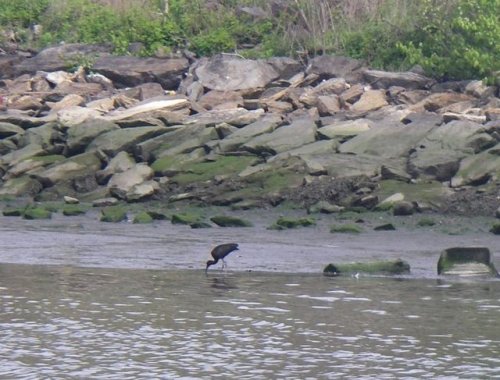By Erik Baard
Up to a point, I love being ignorant. As an aspiring urban naturalist, I am frequently discovering my hometown’s exoticism. I had one such moment on Saturday, as I paddled up the Bronx River with a boathouse volunteer to help with the Amazing Bronx River Flotilla.
Stroke by stroke we left the west bank of the Bronx River mouth’s grocery store distributor truck lots, warehouse construction, and the old sanitation pier further behind. Retaining walls ended and broad mudflats footed the green, landfilled uplands of Soundview Park. Brilliant white birds stole our attention first – three great egrets and two large mute swans. But after that rush subsided, I noticed the smaller wader silhouetted above (photo by Ted Gruber) and was awed. It was an ambassador from ancient Egypt.
The first time I came across the hooked-bill face of an ibis, it had a human body and was busy teaching Isis spells to resurrect the dismembered Osiris. This was a depiction of the Egyptian god of wisdom, magic, and measurement. He derived his name, Djehuty, as well as visage, from the ibis. He is also credited with inventing writing, and Egyptian scribes often owned depictions of ibises. We more commonly know Djehuty through the Greeks as Thoth. That distinct bill (great for snatching up crustacens, snakes, and invertebrates) stirred Egyptian imaginations further, and they associated the bird, and Djehuty, with the similarly shaped crescent moon. The god is usually attended by a baboon (which is also an occasional incarnation), as Egyptians noticed how that primate seemed to howl at the moon.
As I read those enchanting stories, encountering a living descendent in the South Bronx was nowhere in my thoughts.
During the winter I’d flipped past the ibis in an Audubon Society guide, not having much faith in seeing one. Despite a population surge in the mid-twentieth century, it’s now listed as a species “of greatest conservation concern” in New York. Still, a dedicated birder can count on spotting them in our parts from spring through autumn (they winter in the Deep South); this absolutely breathtaking photo offers a closer look at a glossy ibis in Jamaica Bay, with its breeding plumage, rusty and iridescent green like a dogbane beetle.
But for all its ancient pedigree, the glossy ibis is a newcomer to America. Most scientists believe it arrived in the late 19th century. Now you might ask, “If it’s invasive, why would the Audubon Society be worried about it? Shouldn’t the organization be working to curtail it so that native shorebirds can survive?”
Well, this is partly because the glossy ibis seems to have arrived naturally, swept across the Atlantic Ocean by a hurricane as it migrated between Africa and Europe (this still happens today). And today it’s habitat is threatened by pollution and wetlands draining throughout its current range, even North Africa. Our continent is home to 21,000 ibises, about one percent of the global total, but we could end up serving as a global gene bank for the species.
Or maybe there’s an environmental grant waiting for a revival of the Egyptian solution to species preservation: Temple priests raised the birds in captivity so skillfully that archeologists have uncovered millions of ibis remains…sacrificed and mummified. Or not.
But the next time I see the moon at a crescent sliver, I will see ibis-headed Djehuty and smile knowing I once glided alongside him. I will hope, as a minor scribe, that I have honored him.




